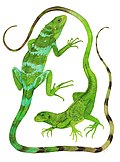Ctenosaura acanthura
| Ctenosaura acanthura | |
|---|---|

| |
| Scientific classification | |
| Domain: | Eukaryota |
| Kingdom: | Animalia |
| Phylum: | Chordata |
| Class: | Reptilia |
| Order: | Squamata |
| Suborder: | Iguania |
| Family: | Iguanidae |
| Genus: | Ctenosaura |
| Species: | C. acanthura
|
| Binomial name | |
| Ctenosaura acanthura (Shaw, 1802)
| |
| Synonyms[3] | |
Ctenosaura acanthura, is a species of iguanid lizard found in eastern Mexico and extreme western Guatemala. The standardized English name is the Mexican spiny-tailed iguana (Spanish: garrobo del noreste).[4]: 58 p. [5] Confusingly however, an earlier edition of standardized names for Mexican herpetofauna called Ctenosaura acanthura the northeastern spinytailed iguana and applied the name Mexican spinytailed iguana to Ctenosaura pectinata,[6]: 45–46 p. which was called the western spiny-tailed iguana in the second edition.[4]: 58 p. It has also been referred to as the Veracruz spiny-tailed iguana and Gulf Coast spiny-tailed iguana. It is an egg laying species that is mostly herbivorous and a moderately large lizard commonly growing over one meter in total length.[7]: 139–144 p. [3]
Taxonomy
The northeastern spinytail iguana was first described by British zoologist George Shaw in 1802.[8] The generic name, Ctenosaura, is derived from two Greek words: ctenos (Κτενός), meaning "comb" (referring to the comblike spines on the lizard's back and tail), and saura (σαύρα), meaning "lizard".[9] Its specific name is the Greek word akanthos (Ἄκανθος), meaning "thorn".[10]
Description
Mexican spiny-tailed iguanas have distinctive keeled scales on their long tails, which give them their common name.[11] The males are capable of growing up to 1.4 meters (4 ft 7 in) in total length and females slightly shorter at 1 meter (3 ft 3 in).[9] They have a crest of long spines which extends down the center of the back.[11] Their base color is black with white or cream-colored markings.[9][11]
Ctenosaura acanthura is often confused with the closely related and similar appearing black iguana (
Diet and behavior

Northeastern spinytail iguanas are excellent climbers and prefer a rocky habitat with plenty of crevices to hide in, rocks to bask on, and nearby trees to climb.
They are primarily
Distribution

Ctenosaura acanthura occurs in the lowlands on the eastern versant of Mexico throughout the
The status of six specimens collected near the town of
Reproduction

Mating generally occurs in the spring. A male shows dominance and interest by head bobbing, eventually chasing the female until he can catch her and subdue her.
References
- . Retrieved 19 November 2021.
- ^ "Appendices | CITES". cites.org. Retrieved 2022-01-14.
- ^ a b Ctenosaura acanthura at the Reptarium.cz Reptile Database. Accessed 13 November 2015.
- ^ a b Liner, E. A. and G. Casas-Andreu. 2008. Standard Spanish, English and scientific names of the amphibians and reptiles of Mexico Society for the Study Amphibians and Reptiles. Herpetological Circular 38: i-iv, 1-162.
- ^ Lemos Espinal, J. A. (Editor) 2015. Amphibians and Reptiles of the US-Mexican Border States. Texas A&M University Press. College Station, Texas. x, 614 pp.
- ^ Liner, E. A. 1994. Scientific and common names for the amphibians and reptiles of Mexico in English and Spanish. Society for the Study Amphibians and Reptiles. Herpetological Circular 23: i-iii, 1-113.
- ^ a b c Köhler, G. 2008. Reptiles of Central America, 2nd Edition. Herpeton, Verlag Elke Köhler, Offenbach, Germany. 400 pp.
- ^ "Ctenosaura acanthura". Integrated Taxonomic Information System. Retrieved 30 September 2008.
- ^ a b c d e f g h i j Malfatti, Mark (2007), "A look at the genus Ctenosaura: meet the World's fastest lizard and its kin", Reptiles Magazine, 15 (11): 64–73
- ^ a b
Hollingsworth, Bradford D. (2004), "The Evolution of Iguanas: An Overview and a Checklist of Species", Iguanas: Biology and Conservation, University of California Press, pp. 34–35, ISBN 978-0-520-23854-1
- ^ Senckenbergiana Biologica, 30 (1): 33–43
- ^ a b c Köhler, G. 2002. Schwarzleguane: Lebensweise, Pflege, Zucht. Herpeton, Verlag Elke Köhler, Offenbach, Germany. 142 pp.
- ^ Lemos-Espinal, Julio A., Daniel B. Wylie, and Geoffrey R. Smith. 2017. New distributional records for reptiles from Nuevo León, Mexico. Herpetology Notes, 10: 639-641.
- ^ Smith, H. M. and E. H. Taylor. 1966. Herpetology of Mexico: Annotated Checklist and Keys to the Amphibians and Reptiles. A reprint of Bulletins 187, 194 and 199 of the U. S. Nat. Mus. with a list of subsequent taxonomic innovations. Eric Lundberg, Ashton, Maryland.
External links
 Data related to Ctenosaura acanthura at Wikispecies
Data related to Ctenosaura acanthura at Wikispecies- West Coast Iguana Research


